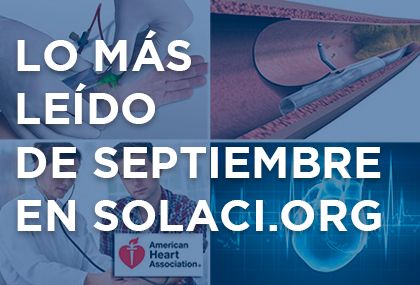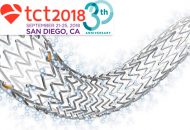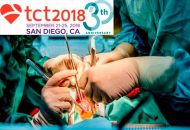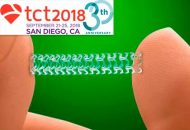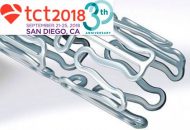1- High-Sensitivity Troponins Turned All Events into Infarctions; the 4th Universal Definition Clarifies Things Myocardial infarction or myocardial injury? The Fourth Universal Definition of Myocardial Infarction (an update of the 2012 version) is here to clarify that not all cases of elevated cardiac troponin values are acute myocardial infarctions. Read more 2- A Simple…
TCT 2018 | CorMicA Trial: Coronary Function in Patients with Angina and Normal Coronary Arteries
Angina pectoris without stenosis in the epicardial coronary arteries is a common problem with several possible underlying causes. The main purpose of this work was to test the hypothesis that stratified medical therapy guided by an interventional diagnostic procedure might improve outcomes. Patients without coronary lesions and with angina were immediately randomized 1:1 to an…
TCT 2018 | ABSORB IV: Much Life Left for Bioresorbable Scaffolds
Previous studies have documented higher rates of adverse events with bioresorbable scaffolds (ABSORB) compared with metallic drug-eluting stents (DES). However, these studies included lesions smaller than recommended for these scaffolds and a suboptimal implantation technique. The ABSORB IV study, presented by Dr. Stone at TCT 2018 and published simultaneously in The Lancet, randomized patients to polymeric everolimus-eluting scaffold Absorb…
TCT 2018 | OAC-ALONE: Anticoagulation Alone 1 Year After Stenting in Patients with Atrial Fibrillation
Up to now, there had been no randomized controlled trial assessing oral anticoagulation alone vs. oral anticoagulation plus antiplatelet therapy in patients with atrial fibrillation 1 year after stenting in a setting of stable coronary disease. Such was the vacuum that this work, presented at TCT 2018 and published simultaneously in Circulation, attempted to fill. This trial…
TCT 2018 | LRP: Infrared Technology for the Detection of Vulnerable Patients and Plaques
Despite optimal medical treatment and modification of risk factors, patients may spend long periods without symptoms and then experience acute coronary syndrome without any prior indication that may allow us to predict the time of occurrence. This is why the possibility of detecting patients with vulnerable plaques and who are at higher risk is very…
TCT 2018 | FAST-FFR: Angiography-Derived FFR Without Hyperemic Stimulus or Invasive Guidewire Placement
All over the world, functional lesion measurement remains underutilized due to the need for a hyperemic stimulus (which may be avoided with instantaneous wave-free ratio [iFR]) and, above all, the invasiveness of guidewire placement (crossing the intended lesion) for the measurement. These guidewires have improved a lot, but they still lack the navigating capacity of…
TCT 2018 | ReCre8 Trial: Permanent Polymer and Zotarolimus vs. Polymer-Free Amphilimus
Polymer-free amphilimus-eluting stents are a novel technology combining sirolimus and long-chained fatty acids. This enhances the uptake of antiproliferative agents and may be associated with lower restenosis, particularly among patients with diabetes. The new device includes abluminal reservoirs filled with the drug; in consequence, there is no need for polymer. This work compares this new…
TCT 2018 | MAIN COMPARE: Angioplasty vs. Surgery for Left Main Coronary Artery Disease at 10 Years
Several studies (some of them recent, some of them not so much so) have compared left main coronary artery angioplasty and myocardial revascularization surgery. Combined, these works compose a large corpus of evidence, but follow-up has not gone beyond 5 years in any case. The main aim of this study (presented at TCT 2018 and published simultaneously…
TCT 2018 | BIONYX: Durable Polymer-Coated vs. Ultrathin-Strut, Bioresorbable Polymer-Coated DES
This work, presented at TCT 2018 and published simultaneously in The Lancet, is the first randomized study comparing a zotarolimus-eluting stent with a new thin-strut structure and limited radiographic visibility (Onyx), and a bioresorbable polymer-coated sirolimus-eluting stent (Orsiro). Onyx was developed to improve visibility while reducing strut thickness. To that end, a dense platinum–iridium core and…
TCT 2018 | RESET: Everolimus DES vs. Sirolimus First Generation DES at Long Term
This study had published thrombosis and revascularization rates at one year after stenting, but today one year seems rather short, which is why this cohort was followed up for 5 to 7 years more, to be able to properly assess the differences between first and second generation DES. There were no significant differences a t…
TCT 2018 | ULTIMATE: IVUS Guided DES Implantation for All Vessels, for All Lesions
Intravascular Ultrasound (IVUS) guided drug eluting stent (DES) implantation is associated with less adverse events compared against angiography guided stenting. This is especially clear for certain populations (with left main PCI as paradigmatic) but not so clear when dealing with all comers. 1448 all comer patients requiring DES stenting were randomized 1:1 to IVUS guided…
